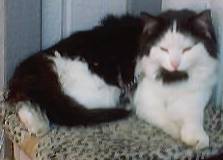What causes Respiratory Problems in Cats?
Please Help Pets with a Small Gift of Only One Dollar
Cat Respiratory Problems
Suvi Pohjola-Stenroos, DVM, PhD
Herpesvirus
Calicivirus
Chlamydia psittaci
Mycoplasma
Feline upper respiratory problems occur very often, especially in cattery
cats. They may be caused by viral infections or bacteria or both. Besides
infectious agents we sometimes can determine that symptoms are caused by
inhalent allergens (those will not be covered by this article).
Herpesvirus (rhinotracheitis)
Herpes infection is the most prevalent disease in cattery cats. The virus
genome remains in the trigeminal ganglion in the head until the animal is
stressed. Then the virus is activated, grows down into the nerve and reinfects
the mucosal cells where it replicates and is shed. Animals that are infected
remain latent carriers, that is they will shed the virus whenever they are
stressed. The first episode will normally last several weeks, but recurrent
infection lasts 3-10 days.
Clinical signs are ocular or systemic:
Bilateral keroconjunctivitis, and some corneal ulcers may be seen
especially in those breeds with large eyes. The eyes are very painful. The cat
will keep the eyes mostly closed, and massive production of tears can be
observed.
Systemic signs include rhinitis, that is an inflammation of the nasal
mucosa. So the cat will sneeze. First the secretion is watery, but later on it
will appear mucopurulent, because the mucosal lining will ulcerate and
secondary bacteria will adhere.
Some cats will develop chronic rhinitis/sinusitis due to the permanent
turbinate damage of the nasal cavity.
Pneumonia in very young kittens may lead to rapid death.
The diagnosis of herpes virus infection is made by culturing nasal, ocular
or oropharyngal exudates. Also intranuclear inclusion bodies can sometimes be
seen in cell scrapings taken from the conjunctiva.
The treatment includes antiviral drugs (ophtalmic solutions in the eyes),
systemic antibiotics to prevent secondary bacteria, fluids if necessary and
other supportive care in the acute phase.
In chronic cases you can keep the nasal passages clear for example with
Neosynephrine (use every day).
Steroids (cortisone) are always contraindicated as they reactivate the
infection and suppress immunity. Steroids also prevent corneal ulcers from
healing.
Prevention is the most important task. Vaccinate your cat properly.
Do not use modified live vaccines because you bring live virus contamination
to your cattery. Especially if you suspect corneal ulceration never use
modified live vaccines.
Calicivirus
Calici is very common, about 20% of cats shed this virus. There are several
strains, and vaccine strains are not necessarily the same as those that occur
in catteries. Calici is shed from oropharynx into the saliva, some is shed via
feces.
Calicivirus infection is best treated with supportive care. Put the cat on a
soft food diet which allows the lesions to heal.
Chronic cats should be tested for FelV and FIV infection. Preventive
treatment is best.
Chlamydia psittaci
Chlamydia is a bacteria and common in cattery cats. Primarly affects kittens
around weaning when they have poor maternal immunity left. Kittens are
infected by adult cats or older kittens. Transmission occurs through feces and
discharges (eye and nose). recovered cats may become carriers and often don't
develop good immunity. Recurrent infections may happen, but often they
devrease with maturation of the immune system.
Clinical signs are: unilateral conjunctivits, also severe conjunctivitis in the unopened eyes
of the newborn kitten is possible. Some young kittens (2-4 weeks) may develop
fatal pneumonia leading to death. Often we don't see the respiratory signs at
all, we just see the death.
Chlamydia also induces reproductive problems and abortion. Diagnosis in
chlamydial problems is based on examination of conjunctival scrapings, or so
called IFA-test.
Chlamydial infections are best treated with tetracyclins and their
derivates, treatment time may be long, and dosing should be continued for 2
weeks after the resolution of the clinical signs.
Preventive measures includes good cattery management, especially hygiene.
Mycoplasma
Bacteria. Cattery cats are susceptible, recovered animals my become carriers.
Mycoplasma is shed in exudates.
Signs are mainly ocular: uni- or bilateral conjunctivitis, not very painful. The cat can get
concurrent chlamydial infection. Systemic signs may develop in 3-4 weeks old
kittens. Mycoplasma may induce abortion in the queen. Diagnosis is made by
conjunctival scrapings and also by culturing in special agar plates. There is
no vaccine available.
Treatment is with tetracyclins or their derivates at least for 2 weeks.
This antibiotic is static for the bacteria, thus the cat's immunity must kick
the bacteria away.
Jesi
